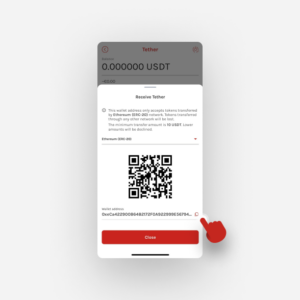[key_takeaways title="To send Tether, follow these steps:"]
- Open Your Wallet App
- Select USDT
- Choose to Send
- Enter the Recipient's Address
- Enter Amount
- Confirm the Transaction
- Wait for Confirmation
[/key_takeaways]
Sending Tether (USDT) between digital wallets is a fundamental process for cryptocurrency users. Whether managing your investments, paying for services, or transferring funds, understanding how to move your USDT securely is crucial.
This guide provides a succinct, step-by-step approach to sending USDT, ensuring that even those new to cryptocurrencies can complete transactions confidently and safely. Let’s delve into the specifics of how to manage your transfers efficiently.
How does Tether (USDT) transfer work?
Tether (USDT) transfers work on the principle of blockchain technology, ensuring secure, transparent, and immutable transactions.
When you send USDT, the transaction is broadcast to the blockchain network, where it undergoes verification by network participants. This process includes checking the validity of the transaction details, such as the wallet address and transaction amount, against the sender’s available balance.
Once verified, the transaction is added to a block on the blockchain, effectively transferring the specified amount of USDT from the sender’s wallet to the recipient’s address. This ledger update is then propagated across all copies of the blockchain, ensuring everyone has the same accurate record of transactions.
The decentralized nature of blockchain ensures that no single entity controls the transaction process, enhancing the security and reliability of USDT transfers.

Why would someone want to send Tether (USDT)?
Sending Tether (USDT) offers numerous benefits, making it a popular choice for various financial activities. Here are some reasons why someone might choose to send USDT:
- Stability: Tether, one of the most popular digital assets, offers stability and ease of transaction within the volatile cryptocurrency market. As a stablecoin pegged to traditional fiat currencies like the US dollar, USDT provides a stable medium of exchange, protecting against the volatility often associated with other cryptocurrencies. This makes USDT ideal for transactions where the exact value needs to be preserved.
- Global transactions: Sending USDT allows for fast, cross-border transactions without the need for traditional banking systems or concerns about exchange rates. It’s a cost-effective way to transfer value globally.
- Integration with digital services: Many online platforms and services accept USDT as payment, making it a convenient option for accessing digital goods, services, and investment opportunities.
- Privacy and security: Blockchain transactions offer a higher level of privacy compared to traditional bank transfers. While the transaction history is public, the parties’ identities are not directly tied to their wallet addresses.
- Ease of use: With just a few taps in a digital wallet app, users can send crypto to anyone with a compatible wallet. This ease of use, combined with the security of blockchain technology, makes USDT an attractive option for newcomers and seasoned cryptocurrency enthusiasts.
In essence, sending USDT combines the stability of fiat currency with the innovation and freedom of digital currencies, offering a versatile and secure method for managing digital assets.
What is the quickest way to transfer Tether (USDT) between wallets?
The quickest way to transfer Tether (USDT) or other cryptocurrency between wallets is through wallets that support direct and instant transfer features.
These wallets utilize the underlying blockchain’s capabilities for rapid transactions, with some platforms offering proprietary solutions that facilitate immediate transfers without the need for blockchain confirmation times.
For instance, transferring USDT between two accounts on the same exchange or wallet service can be instantaneous, as the transaction occurs internally within the platform’s system.
Furthermore, selecting the Tron network for USDT transfers is recognized for its speed and low transaction costs, making it a preferred choice for users prioritizing quick and efficient transactions.
The Tron network, by design, supports high transaction throughput and minimal fees, ensuring that your transfers are processed with remarkable speed compared to other blockchain networks.
Using a fast blockchain network and leveraging instant transfer services within platforms presents the most rapid method of sending USDT between wallets.
📚Read more: TRC-20 vs. ERC-20: Differences Between USDT Networks
How to send Tether (USDT) to another wallet (Step-by-step)
Our step-by-step guide is designed to assist even the most novice users in transferring USDT between wallets:
- Open your wallet app: Open the digital wallet application where your USDT is stored. This could be a standalone wallet like Trust Wallet or swissmoney, or a wallet provided by a cryptocurrency exchange.
- Navigate to USDT: Within your wallet, find and select Tether (USDT) from the list of available cryptocurrencies. This will take you to the section of your wallet specifically for managing your USDT.
- Choose the send option: Look for a “Send” button or option within the USDT section of your wallet. This action will open the interface for initiating a USDT transfer.
- Enter the recipient’s address: Carefully input the address of the recipient to whom you want to send crypto. Double-check this address for accuracy to avoid sending funds to the wrong address. To ensure accuracy when entering a recipient’s wallet address, you can simply scan their QR code if it’s provided.
- Specify the amount of USDT to send: Enter the amount of Tether (USDT) you wish to transfer. Ensure you have enough USDT for the transfer, including any transaction fees.
- Review transaction details: Before proceeding, review all transaction details, including the recipient’s address, the amount of USDT sent, and the network fees. Some wallets allow you to choose the speed of the transaction, which can affect the fee.
- Confirm and send: Once you’ve verified that all information is correct, confirm the transaction. Depending on your wallet’s security settings, you may need to enter a PIN or password or use biometric verification.
- Wait for confirmation: After sending, you will receive a transaction ID or hash. You can use this ID to track the progress of your transfer on the blockchain. Once the network confirms the transaction, the recipient’s wallet will reflect the incoming USDT.
These eight steps provide a comprehensive guide to securely sending crypto to another wallet. Transaction speeds and fees can vary depending on network congestion and the blockchain you use (e.g., Ethereum or Tron).
📚Read more: How to Create a Crypto Wallet for Beginners
Want to send USDT easily, quickly, and securely? Discover swissmoney!
swissmoney offers a streamlined approach to managing your crypto and fiat currencies, simplifying the sending process. Here’s why swissmoney stands out:
- All-in-one platform: Seamlessly manage crypto and traditional currencies in one place.
- Generous limits: Benefit from high transaction limits for your financial moves.
- Dedicated IBAN accounts for effortless global transactions in both crypto and fiat.
- Integrated crypto wallet: Securely store, send, and receive USDT with an in-built wallet.
- Crypto virtual debit card: Spend your USDT easily with a versatile virtual debit card.
For efficient digital and traditional currency management, swissmoney is the ideal choice, merging the worlds of crypto and fiat with ease.
How to send Tether (USDT) to swissmoney wallet
Follow these simple steps to deposit USDT into your swissmoney wallet securely:
1. Log in to your swissmoney account: Access your swissmoney account through the app or website.

2. Navigate to the Digital assets section: Find the cryptocurrency management section on the dashboard.

3. Select ‘Receive’ USDT: Choose the option to receive Tether (USDT) to generate your swissmoney USDT address.

4. Copy the wallet address: Ensure you copy the USDT address accurately to avoid transaction errors.

5. Open your external wallet: Access the wallet where your USDT is stored.
6. Initiate a transfer: Select the option to send USDT and paste your swissmoney wallet address as the recipient. When you send USDT to your swissmoney wallet, the funds are automatically converted to your preferred fiat currency if you choose to.
7. Confirm and send: Enter the amount of USDT you wish to transfer, review the transaction details for accuracy, and confirm the send.
8. Wait for confirmation: Once the transfer is complete, the USDT tokens will appear in your swissmoney wallet, ready for any transactions you wish to perform.
You can transfer USDT from your swissmoney wallet directly to your bank account, where it will be ready for everyday use.
📚Related: How To Withdraw USDC To Bank Account
How to send Tether (USDT) to Trust Wallet

Use this guide to transfer Tether (USDT) into your Trust Wallet efficiently:
- Open Trust Wallet: Launch the Trust Wallet app on your device.
- Select ‘Receive’: Tap on the ‘Receive’ button and choose Tether (USDT) from the list of cryptocurrencies.
- Copy your USDT address: Your Trust Wallet’s USDT address will be displayed. Copy this address.
- Go to your sending wallet: Open the wallet or exchange where your USDT is currently held.
- Choose ‘Send’ USDT: Look for the send or transfer option within your wallet and select it.
- Paste your Trust Wallet address: Enter the previously copied Trust Wallet USDT address as the destination.
- Enter the amount and confirm: Specify the USDT amount you want to send and double-check all details before confirming the transaction.
- Transaction completion: Your USDT will appear in your Trust Wallet once the blockchain has processed the transaction.
📚Read more: How to Withdraw From Trust Wallet
How to send Tether (USDT) to Coinbase Wallet

Follow these easy steps to send Tether (USDT) to your Coinbase Wallet:
- Access your Coinbase wallet: Open your Coinbase Wallet app or log in via the web interface.
- Find the ‘Receive’ option: Navigate to the ‘Receive’ section and select Tether (USDT) to view your wallet address.
- Copy the USDT address: Make sure to copy your Coinbase Wallet’s USDT address accurately.
- Open the wallet holding your USDT: Switch to the wallet or platform where your Tether is stored.
- Initiate a USDT send: Use the send or transfer function to start sending Tether.
- Enter the Coinbase address: Paste your Coinbase Wallet’s USDT address into the recipient field.
- Specify the amount and confirm: Choose how much USDT you wish to send to your Coinbase Wallet, review the transaction details, and confirm.
- Await confirmation: After the network confirms the transaction, the USDT will be transferred to your Coinbase Wallet.
How to send Tether (USDT) to MetaMask Wallet

Here’s a quick guide to help you send Tether (USDT) to your MetaMask Wallet:
- Install MetaMask: Ensure you have the MetaMask extension installed on your browser or the app on your mobile device.
- Add USDT to MetaMask: By default, MetaMask might not display USDT. To add it, go to the ‘Assets’ tab, scroll down, and click ‘Add Token’. Choose ‘Custom Token,’ and enter the USDT contract address (which you can find on a reputable crypto information website like CoinMarketCap or Etherscan).
- Copy your MetaMask address: Click on your account name at the top of the MetaMask app to copy your wallet address to the clipboard.
- Access your current USDT wallet: Open the wallet or exchange where your USDT is stored.
- Initiate a transfer to MetaMask: Within your current wallet, find the option to send or transfer USDT, and paste your MetaMask wallet as the recipient.
- Confirm the transaction details: Enter the USDT amount you want to transfer. Double-check the address and amount, then confirm the transfer.
- Wait for transfer completion: MetaMask will notify you once the USDT has been received. Depending on network congestion, this may take a few minutes.
[note title="Note"]
All information provided is dated 12 April 2024 and may have been updated since. Please check each platform’s official website for the latest information.
[/note]
What to consider before sending Tether (USDT) to another wallet
Keep in mind these essential factors to ensure a secure and successful transfer of Tether (USDT) to another wallet:
- Transaction fees: Check the current network fees for sending Tether, as they can vary significantly depending on network congestion and the blockchain used (Ethereum, Tron, etc.).
- Recipient’s address accuracy: Ensure you have the correct recipient address. Transactions are irreversible, and funds sent to the wrong address cannot be recovered.
- Network compatibility: To avoid fund loss, ensure the sending and receiving wallets support the same network version of USDT (ERC-20, TRC-20, etc.) and are on the same Ethereum network to avoid transfer discrepancies with USDT.
- Wallet compatibility: Confirm that the recipient’s wallet supports USDT. Not all wallets support all tokens or networks.
- Confirmation time: Be aware that transaction confirmation times can vary. While some networks are faster, others may take longer, especially during peak times.
📚Related: How Much Does It Cost to Send Tether (USDT)?
What are the most common security Risks Associated with sending Tether (USDT)?
Stay informed about the common security risks to safeguard your Tether (USDT) transactions against potential threats:
- Phishing scams: Attackers might pose as legitimate entities and try to trick you into sending Tehter to their addresses. Always double-check URLs and email addresses.
- Malware: Malicious software can alter clipboard data, changing copied wallet addresses to those controlled by attackers. Always verify the pasted address.
- Man-in-the-middle attacks: When using unsecured networks, attackers could intercept transactions and redirect funds. Use secure, private networks for transactions.
- Smart contract vulnerabilities: If sending Tether to a contract address (for example, for a token swap), ensure the contract has been audited and is secure. Flaws in contract code can lead to loss of funds.
- Lost access: Losing access to the wallet from which you’re sending Tether can result in irreversible loss if you need to cancel or modify the transaction. Ensure your wallet’s backup and recovery methods are up to date.
Conclusion
In conclusion, transferring Tether (USDT) between wallets is a common and straightforward process in cryptocurrency. By following the detailed steps provided for various wallets, users can efficiently manage their USDT transactions.
However, it’s crucial to be mindful of the security risks and consider factors like transaction fees, network compatibility, and wallet support to ensure a smooth and secure transfer experience. With proper knowledge and precautions, sending and receiving USDT can be a seamless part of your digital finance management.
FAQs
Can I transfer Tether (USDT) from one wallet to another?
Yes, you can transfer Tether (USDT) from one wallet to another. Ensure both wallets support the specific USDT blockchain network you are using (ERC-20, TRC-20, etc.).
How can I send Tether (USDT) to someone?
To send this crypto to someone, access your wallet, select USDT, enter the recipient’s address, specify the amount, and confirm the transaction.
How much Tether (USDT) can I send?
The amount of USDT you can send depends on your wallet balance and any potential wallet or network limitations. Ensure you have enough USDT for the transfer and the required network fees.
Are there any limitations to sending Tether (USDT)?
Limitations can include transaction fees, network congestion, and wallet or exchange limits on transaction amounts. Additionally, ensure network compatibility (e.g., ERC-20, TRC-20) between sending and receiving wallets.
How long does it take to send Tether (USDT) to someone?
Transaction times vary based on network congestion and the blockchain used. ERC-20 transactions might take longer and be more expensive than TRC-20 transactions, especially during peak times.
What are the fees associated with transferring Tether (USDT)?
Fees depend on the blockchain network (Ethereum, Tron, etc.) and current network congestion. ERC-20 transfers generally have higher fees compared to TRC-20 transfers.
How do you send a USDT TRC 20 without fees?
While TRC-20 transfers typically have lower fees than ERC-20, transfers without fees are not standard. Some platforms may offer promotions or special conditions for feeless transactions.
What are the tax implications of sending Tether (USDT)?
Tax implications vary by jurisdiction. Generally, transferring crypto in itself may not trigger a taxable event, but selling USDT for fiat, trading, or using it for purchases might. Consult a tax professional.
What are gas fees, and how do they influence transaction speed?
Gas fees are payments made by users to compensate for the computing energy required to process and validate transactions on the blockchain. Higher gas fees can prioritize your transaction, potentially leading to faster processing times.
How do you check the status of a Tether (USDT) transaction?
You can check the status of a USDT transaction by using the transaction ID (TXID) in a blockchain explorer specific to the network you used (Ethereum, Tron, etc.).
What is the best wallet for Tether (USDT) transfer?
The best wallet for these transfers is subjective and depends on your needs. Popular choices include MetaMask (for ERC-20) and TronLink (for TRC-20) due to their ease of use and security features.
What happens if you send Tether (USDT) to a Bitcoin wallet?
Sending Tether to a Bitcoin address can result in losing your USDT if the wallet does not support the specific blockchain network. Always double-check the recipient’s address and network compatibility.
Is it possible to send Tether (USDT) anonymously?
While blockchain transactions are pseudonymous, complete anonymity can be challenging due to blockchain’s transparency. Some services offer privacy features, but caution and research are advised.
How can I keep my Tether (USDT) safe during transfers?
Ensure the security of your USDT during transfers by double-checking recipient addresses, using secure and reputable wallets, enabling 2FA on your accounts, and keeping your private keys or seed phrases secure and private.

